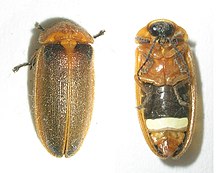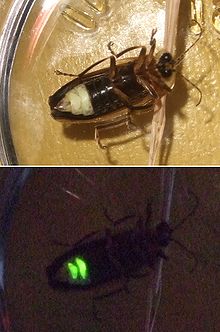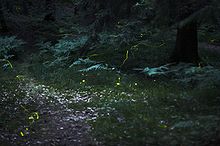Firefly
| Firefly | |
|---|---|

| |
| Unidentified species from India, dorsal (left) and ventral aspect | |
| Scientific classification | |
| Kingdom: | |
| Phylum: | |
| Class: | |
| Order: | |
| Suborder: | |
| Infraorder: | |
| Superfamily: | |
| Family: | Lampyridae Latreille, 1817
|
| Subfamilies | |
|
Cyphonocerinae Genera incertae sedis: | |
Lampyridae is a family of insects in the beetle order Coleoptera. They are winged beetles, and commonly called fireflies or lightning bugs for their conspicuous crepuscular use of bioluminescence to attract mates or prey. Fireflies are capable of producing a "cold light", containing no ultraviolet or infrared rays. This chemically-produced light, emitted from the lower abdomen, may be yellow, green, or pale red in colour, and has a wavelength from 510 to 670 nanometers.
There are more than 2,000 species of firefly found in temperate and tropical environments around the world. Many species can be found in marshes or in wet, wooded areas where their larvae have abundant sources of food. These larvae can also emit light and are often called "glowworms", particularly in Eurasia. In the Americas, "glow worm" also refers to the related Phengodidae.
Biology

Fireflies tend to be brown and soft-bodied, often with the elytra more leathery than in other beetles. Though the females of some species are similar in appearance to males, larviform females are found in many other firefly species. These females can often be distinguished from the larvae only because they have compound eyes. The most commonly known fireflies are nocturnal, though there are numerous species that are diurnal. Most diurnal species are non-luminescent, though some species that remain in shadowy areas can produce light energy.
A few days after mating, a female lays her fertilized eggs on or just below the surface of the ground. The eggs hatch 3-4 weeks later and the larvae feed until the end of the summer. The larvae are commonly called glowworms, not to be confused with the distinct beetle family Phengodidae or fly genus Arachnocampa. Lampyrid larvae have simple eyes. The term glowworm is also used for both adults and larvae of species such as Lampyris noctiluca, the common European glowworm, in which only the non-flying adult females glow brightly and the flying males glow only very weakly and intermittently.
Fireflies overwinter (some species for several years) during the larval stage. Some do this by burrowing underground, while others find places on or under the bark of trees. They emerge in the spring. After several weeks of feeding, they pupate for 1 to 2.5 weeks and emerge as adults. The larvae of most species are specialized predators and feed on other larvae, terrestrial snails, and slugs. Some are so specialized that they have grooved mandibles which deliver digestive fluids directly to their prey. The diet of adults is variable. It has been reported that some are predatory, while others find food on plant pollen and sometimes nectar.
Light production


Light production in fireflies is due to a type of chemical reaction called bioluminescence. This process occurs in specialised light-emitting organs, usually on a firefly's lower abdomen. The enzyme luciferase acts on luciferin, in the presence of magnesium ions, ATP (adenosene triphosphate), and oxygen to produce light. Genes coding for these substances have been inserted into many different organisms (see Luciferase – Applications). Luciferase is also used in forensics, and the enzyme has medical uses.
Bioluminescence is a very efficient process. Some 90% of the energy a firefly uses to create light is actually converted into visible light.[citation needed] By comparison, an incandescent electric bulb can convert only 10 percent of total energy used into visible light, and the remainder is emitted as heat.[1]
For adult beetles, the production of light is primarily used to locate other individuals of the same species for reproduction. Some species, especially lightning bugs of the genera Photinus, Photuris and Pyractomena, are distinguished by the unique courtship flash patterns emitted by flying males in search of females. Females of the Photinus genus generally do not fly, but do give a flash response to males of their own species.

Tropical fireflies, particularly in Southeast Asia, routinely synchronise their flashes among large groups, an example of biological synchronicity. In some fields, this phenomenon is explained as phase synchronization[2] and spontaneous order. At night along river banks in the Malaysian jungles (most notably found near Kuala Selangor), fireflies ("kelip-kelip" in the Malay language or Bahasa Malaysia), synchronise their light emissions precisely. Current hypotheses about the causes of this behavior involve diet, social interaction, and altitude. In the United States, one of the most famous sightings of fireflies blinking in unison occurred near Elkmont, Tennessee in the Great Smoky Mountains during the second week of June 2005[1]. Congaree National Park in South Carolina is another host to the phenomenon [2].
Female Photuris fireflies are known for mimicking the mating flashes of other "lightning bugs" for the sole purpose of predation. Target males are attracted to what appears to be a suitable mate, and are then eaten. For this reason the Photuris species are sometimes referred to as "femme fatale fireflies".
Many fireflies do not produce light. Usually these species are diurnal, or day-flying, such as those in the genus Ellychnia. A few diurnal fireflies that primarily inhabit shadowy places, such as beneath tall plants or trees, are luminescent. One such genus is Lucidota.
All fireflies glow as larvae. Bioluminescence serves a different function in lampyrid larvae than it does in adults. It appears to be a warning signal to predators, since many firefly larvae contain chemicals that are distasteful or toxic.
Systematics

Firefly systematics, as with many insects, are in a constant state of flux, as new species continue to be discovered. The five subfamilies listed above are the most commonly accepted ones, though others such as the Amydetinae and Psilocladinae have been proposed. This was mainly done in an attempt to revise the Lampyrinae, which by and by had become something of a "wastebin taxon" to hold incertae sedis species and genera of fireflies. Other changes have been proposed, such as merging the Ototetrinae into the Luciolinae, but the arrangement used here appears to be the most frequently-seen and stable layout for the time being. Though most groups by and large appear to be monophyletic, some (e.g. the tribe Photinini) are perhaps better split up.
There seem to be two groups of subfamilies: one containing many American and some Eurasian species in the Lampyrinae and Photurinae, and one predominantly Asian one made up from the other subfamilies. While the subfamilies as understood here are monophyletic by and large, there are still a few genera that need to be moved about for the subfamilies to accurately represent the evolutionary relationships among the fireflies.
The Rhagophthalmidae are a glow worm-like lineage of Elateroidea. They have in the recent past usually been considered a distinct family, but it is still disputed whether this is correct. Indeed, they might be the only close relative of the puzzling firefly genus Pterotus which sometimes is placed in a monotypic subfamily.
The genus Phausis, usually placed in the tribe Photinini of the Lampyrinae, might represent another rather distinct lineage instead.
References
- ^ General Electric TP-110, page 23, table.
- ^ Murray, James D. (2002), Mathematical Biology, vol. I. An Introduction (Third ed.), Springer, pp. 295–299, ISBN 9780387952239
- http://members.jcom.home.ne.jp/hotaru-net/. A site about Japanese aquatic firefly habits, life-history, biology, resources, and activities.
- http://members.jcom.home.ne.jp/hotaru-net/photo/firefly.html. Collections of habits photographs of the Japanese aquatic firefly.
- http://www.ncbi.nlm.nih.gov/Taxonomy/Browser/wwwtax.cgi
- http://www.iisc.ernet.in/academy/resonance/Sept2002/pdf/Sept2002p49-55.pdf
- Branham, M. A., and J. W. Wenzel. 2003. The origin of photic behavior and the evolution of sexual communication in fireflies (Coleoptera: Lampyridae). Cladistics 19: 1-22.
- Stous, Hollend. 1997. A review of predation in Photuris, and its effects on the evolution of flash signaling in other New World fireflies. http://www.colostate.edu/Depts/Entomology/courses/en507/papers_1997/stous.html
- http://www.fireflies.tk . A site about the Firefly meeting 2007 in Portugal and information on fireflies in general.
- http://pirilampos-lightalive.blogspot.com/. A site about bioluminescence and Firefly project in Portugal.
